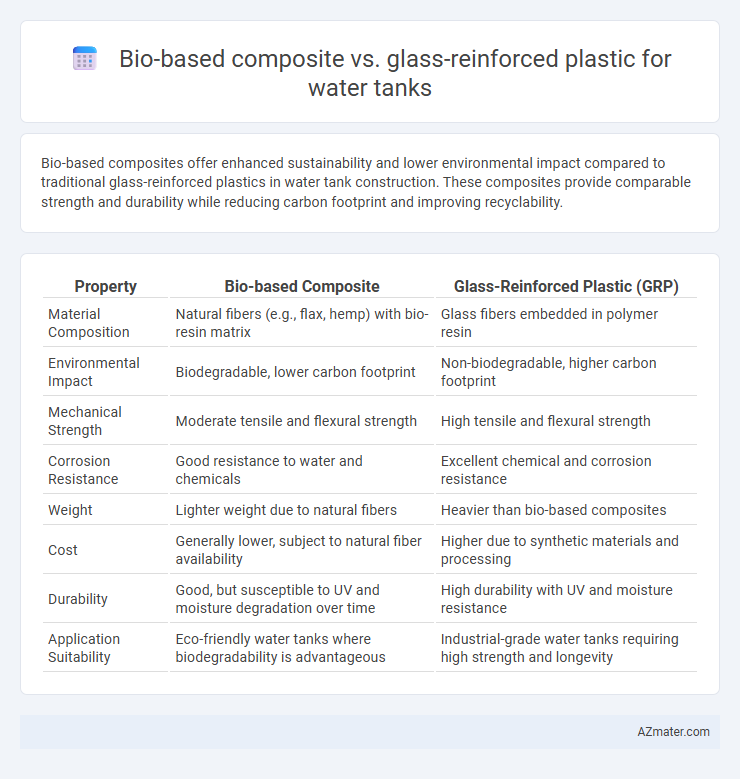Bio-based composites offer enhanced sustainability and lower environmental impact compared to traditional glass-reinforced plastics in water tank construction. These composites provide comparable strength and durability while reducing carbon footprint and improving recyclability.
Table of Comparison
| Property | Bio-based Composite | Glass-Reinforced Plastic (GRP) |
|---|---|---|
| Material Composition | Natural fibers (e.g., flax, hemp) with bio-resin matrix | Glass fibers embedded in polymer resin |
| Environmental Impact | Biodegradable, lower carbon footprint | Non-biodegradable, higher carbon footprint |
| Mechanical Strength | Moderate tensile and flexural strength | High tensile and flexural strength |
| Corrosion Resistance | Good resistance to water and chemicals | Excellent chemical and corrosion resistance |
| Weight | Lighter weight due to natural fibers | Heavier than bio-based composites |
| Cost | Generally lower, subject to natural fiber availability | Higher due to synthetic materials and processing |
| Durability | Good, but susceptible to UV and moisture degradation over time | High durability with UV and moisture resistance |
| Application Suitability | Eco-friendly water tanks where biodegradability is advantageous | Industrial-grade water tanks requiring high strength and longevity |
Introduction to Water Tank Materials
Water tanks primarily utilize materials like bio-based composites and glass-reinforced plastics, each offering distinct benefits in durability and environmental impact. Bio-based composites combine renewable natural fibers with polymer matrices, enhancing biodegradability and reducing carbon footprint compared to conventional materials. Glass-reinforced plastic (GRP) provides high tensile strength, corrosion resistance, and long service life, making it a popular choice for water storage applications demanding structural integrity and chemical stability.
Overview of Bio-Based Composites
Bio-based composites for water tanks utilize natural fibers such as hemp, flax, or jute combined with biodegradable resins, offering enhanced environmental sustainability over traditional glass-reinforced plastics (GRP). These composites exhibit comparable mechanical strength, improved resistance to UV degradation, and lower carbon footprint due to renewable raw materials. Their use aligns with increasing demand for eco-friendly alternatives in water storage applications, reducing reliance on petroleum-based components inherent in GRP.
Characteristics of Glass-Reinforced Plastic (GRP)
Glass-Reinforced Plastic (GRP) water tanks exhibit high strength-to-weight ratios, excellent corrosion resistance, and durability against UV exposure, making them ideal for long-term water storage. GRP's non-porous surface prevents microbial growth, ensuring water quality remains uncontaminated, while its lightweight nature facilitates easier transportation and installation compared to traditional materials. The material's thermal stability and resistance to chemical degradation further enhance the lifespan and maintenance efficiency of GRP water tanks.
Mechanical Strength Comparison
Bio-based composites exhibit competitive mechanical strength compared to glass-reinforced plastics (GRP) for water tank applications, offering tensile strengths typically ranging from 50 to 150 MPa, while GRP usually achieves 100 to 300 MPa. The stiffness and impact resistance of GRP often surpass bio-based composites due to the high modulus of glass fibers, enhancing durability under dynamic loads. However, advances in natural fiber treatments and hybrid composites are closing the mechanical performance gap, making bio-based options increasingly viable for sustainable water tank solutions.
Environmental Impact and Sustainability
Bio-based composites for water tanks offer significantly lower carbon footprints compared to glass-reinforced plastics (GRP), utilizing renewable materials such as natural fibers and bio-resins that reduce reliance on fossil fuels. End-of-life biodegradability or recyclability of bio-based composites enhances sustainability by minimizing landfill waste and environmental pollution associated with GRP, which often contains non-recyclable thermoset resins. Life cycle assessments confirm that bio-based composites contribute to reduced greenhouse gas emissions and resource depletion, positioning them as a more eco-friendly alternative for sustainable water storage solutions.
Cost Analysis and Economic Viability
Bio-based composites for water tanks typically offer lower lifecycle costs due to reduced environmental impact and potential for local material sourcing, compared to glass-reinforced plastics (GRP), which involve higher raw material and manufacturing expenses. While GRP provides superior durability and resistance to corrosion, its initial investment and disposal costs contribute to lower overall economic viability in eco-conscious markets. Cost-benefit analysis reveals bio-based composites as more economically viable for sustainable infrastructure projects prioritizing long-term savings and reduced carbon footprint.
Durability and Longevity Performance
Bio-based composites exhibit strong resistance to corrosion and UV degradation, enhancing the water tank's durability in harsh environments compared to glass-reinforced plastic (GRP). GRP offers superior mechanical strength and impact resistance, maintaining structural integrity over prolonged periods under load and pressure. Both materials provide long-lasting performance, but bio-based composites deliver improved environmental sustainability alongside comparable lifespan in water storage applications.
Resistance to Corrosion and Chemical Exposure
Bio-based composites exhibit superior resistance to corrosion and chemical exposure compared to glass-reinforced plastic (GRP) in water tank applications due to their natural fiber matrices that are less prone to chemical degradation. GRP tanks, while strong and durable, can suffer from resin degradation and localized corrosion when exposed to aggressive chemicals or prolonged moisture contact. The bio-based composites' enhanced chemical stability ensures longer service life and reduced maintenance in environments with high corrosive agents.
Installation and Maintenance Considerations
Bio-based composite water tanks offer easier installation due to their lighter weight compared to glass-reinforced plastic (GRP) tanks, reducing labor and transportation costs. Maintenance for bio-based composites typically requires less frequent inspections since they resist UV degradation and corrosion better than GRP, which may suffer from surface delamination over time. Both materials require routine cleaning, but GRP tanks often need specialized resin repairs, whereas bio-based composites can be maintained with standard eco-friendly treatments.
Future Trends and Industry Adoption
Bio-based composites are gaining momentum in the water tank industry due to their sustainability, reduced carbon footprint, and improved biodegradability compared to traditional glass-reinforced plastics (GRP). Innovations in resin formulation and fiber treatment enhance the mechanical properties and durability of bio-composites, making them competitive alternatives for long-term water storage solutions. Industry adoption is accelerating as regulatory frameworks favor eco-friendly materials, and manufacturers increasingly invest in scalable production techniques for bio-based composites.

Infographic: Bio-based composite vs Glass-reinforced plastic for Water tank
 azmater.com
azmater.com